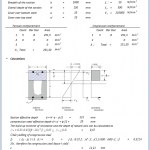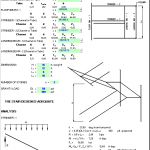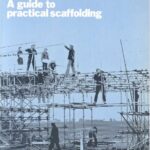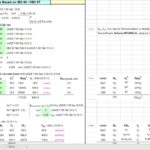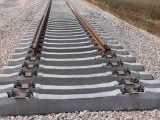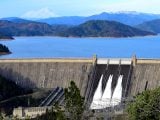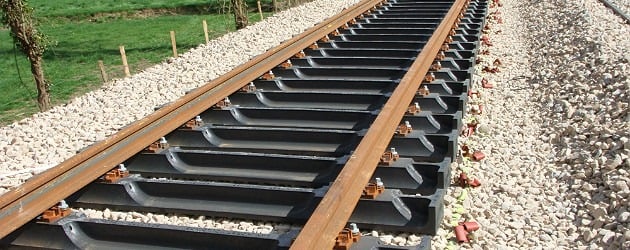
Railway Sleepers – Types of Sleepers
31 October 2018Table of Contents
Railway Sleepers – Types of Sleepers
Depending upon the position in a railway track, railway sleepers may be classified as:
- Longitudinal Sleepers
- Transverse Sleepers
1. Longitudinal Sleepers
These are the early form of sleepers which are not commonly used nowadays. It consists of slabs of stones or pieces of woods placed parallel to and underneath the rails. To maintain correct gauge of the track, cross pieces are provided at regular intervals.
At present this type of sleepers are discarded mainly because of the following reasons.
- Running of the train is not smooth when this type of sleepers is used.
- Noise created by the track is considerable.
- Cost is high.
2. Transverse Sleepers
Transverse sleepers introduced in 1835 and since then they are universally used. They remove the drawbacks of longitudinal sleepers i.e. the transverse sleepers are economical, silent in operation and running of the train over these sleepers is smooth. Depending upon the material, the transverse sleepers may be classified as:
- Timber/wooden sleepers
- Steel sleepers
- Cast Iron Sleepers
- Concrete Sleepers
Timber or Wooden Sleepers
The timber sleepers nearly fulfilled all the requirements of ideal sleepers and hence they are universally used. The wood used may be like teak, sal etc or it may be coniferous like pine.
The salient features of timber/wooden sleepers with advantages and disadvantages.
Advantages of Timber Sleepers
- They are much useful for heavy loads and high speeds
- They have long life of 10-12 years depending upon the climate, condition, rain, intensity, nature of traffic, quality of wood etc
- Good insulators and hence good for track circuited railway tracks
- They are able to accommodate any gauge
- Suitable for salty regions and coastal areas
- Can be used with any section of rail
- Can be handled and placed easily
- They are not badly damaged in case of derailment
- They are not corroded
- Cheaper than any other types of sleepers
Disadvantages of Timber Sleepers
- Liable to be attacked by vermin so, they must be properly treated before use
- Liable to catch fire
- They do not resist creep
- They are affected by dry and wet rot
- Become expensive day by day
- Life is shorter compare to others
Steel sleepers
They are in the form of steel trough inverted on which rails are fixed directly by keys or nuts and bolts and used along sufficient length of tracks.
Advantages of Steel Sleepers
- Have a useful life of 20-25 years.
- Free from decay and are not attacked by vermins
- Connection between rail and sleeper is stronger
- Connection between rail and sleeper is simple
- More attention is not required after laying
- Having better lateral rigidity
- Good scrap value
- Suitable for high speeds and load
- Easy to handle
- Good resistance against creep
Disadvantages of Steel sleepers
- Liable to corrosion by moisture and should not because in salty regions
- Good insulators and hence cannot be used in track circuited regions
- Cannot be used for all sections of rails and gauges
- Should not be laid with any other types of ballast except store
- Very costly
- Can badly damaged under derailments
- Way gauge is obtained if the keys are over driven
- The rail seat is weaker
- Having good shock absorber as there is not cushion between rail foot and ballast
Cast Iron Sleepers
They consist of two pots or plates with rib and connected by wrought iron tie bar of section of about 2″ ½” each pot or plate is placed below each rail. The pot is oval in shape with larger diameter 2′-0″ and smaller diameter 1′-8″ is preferred. Plate sleepers consist of rectangular plates of size about 2′ – 10′ x 1′ – 0″.
The relative advantages and disadvantages are given below.
Advantages of Cast Iron Sleepers
- Long life upto 50-60 years
- High scrape value as they can be remolded
- Can be manufactured locally
- Provided sufficient bearing area
- Much stronger at the rail seat
- Prevent and check creep of rail
- They are not attacked by vermin
Disadvantages Cast Iron Sleepers
- They are prone to corrosion and cannot be used in salty formations and coastal areas
- Not suitable for track circuited portions of railways
- Can badly damage under derailment
- Difficult to maintain the gauge as the two pots are independent
- Require a large number of fastening materials
- Difficult to handle and may be easily damaged
- Lack of good shock absorber
- They are expensive
Concrete sleepers
R.C.C and pre-stressed concrete sleepers are now replacing all other types of sleepers except to some special circumstances such as crossing bridges etc here timber sleepers are used. They were first of all used in France round about in 1914 but are common since 1950. They may be a twin block sleepers joined by an angle iron. It may be a single block pre-stressed type.
Advantages Concrete Sleeprs
- Durable with life range from 40-50 years
- They can be produced on large quantities locally by installing a plant
- Heavier than all other types thus giving better lateral stability to the track
- Good insulators and thus suitable for use in track circuited lines
- Efficient in controlling creep
- They are not attacked by corrosion
- Free from attacks of vermin and decay, suitable for all types of soils
- Most suitable for welded tracks
- Prevent buckling more efficiently
- Initial cost is high but proves to be economical in long run
- Effectively and strongly hold the track to gauge
- Inflammable and fire resistant
Disadvantages Concrete Sleepers
- Difficult to be handled
- Difficult to be manufactured in different sizes thus cannot be used in bridges and crossing
- Can be damaged easily while loading and unloading


